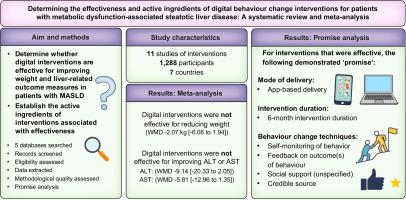Effectiveness and active ingredients of digital behaviour change interventions for MASLD: A systematic review and meta-analysis
IF 7.5
1区 医学
Q1 GASTROENTEROLOGY & HEPATOLOGY
引用次数: 0
Abstract
Background & Aims
Metabolic dysfunction-associated steatotic liver disease (MASLD) is the most prevalent liver condition worldwide. Successful management relies on targeting changes in lifestyle behaviours. Digital behaviour change interventions present a scalable approach to lifestyle change. The aim of this systematic review was to determine the effectiveness and active ingredients of digital behavior change interventions for improving weight and liver-related outcome measures in patients with MASLD.
Methods
Five databases were searched up to 31 January 2025 for studies reporting on digital lifestyle behaviour change interventions for patients with MASLD. Data were meta-analysed or narratively synthesised depending on study design. Intervention content and features positively associated with changes in outcomes of interest were identified using promise analysis.
Results
Eleven studies involving 1,288 participants fulfilled the review criteria. Digital behavior change interventions were not effective for reducing weight (weighted mean difference [WMD] -2.07 kg [-6.08 to 1.94 kg]). Likewise, they did not lead to statistically significant improvements in alanine transaminase and aspartate transaminase (WMD -9.14 [-20.33 to 2.05] and WMD -5.81 [-12.96 to 1.35], respectively). Interventions varied in terms of mode of delivery (e.g. app and SMS), duration (1–11 months), and frequency of delivery (three times/week to continuous access). Promising intervention features/content included app-based delivery, ≥6-month duration, and self-monitoring of behaviour, feedback on outcomes, and social support.
Conclusions
Digital behaviour change interventions did not improve weight and liver-related outcomes measures in patients with MASLD. However, the inclusion of proposed specific intervention ingredients is likely to improve effectiveness.
Impact and implications
This review is the first of its kind to report on the effectiveness and active ingredients of digital behaviour change interventions for the management of MASLD. Although the interventions reviewed were not effective overall, specific features and content of those interventions were associated with effectiveness. These insights can be used to inform the development of new interventions or to optimise existing interventions that could improve effectiveness. Findings also suggest that digital behaviour change interventions are beneficial for a proportion of individuals, and future research should focus on identifying who those individuals are. Significant heterogeneity between interventions was evident in terms of mode of delivery, behavioural change content, duration, and frequency of delivery. To truly determine the effectiveness of digital behaviour change interventions for patients with MASLD, they should be systematically developed using behaviour change theory and in accordance with a recognised intervention development framework.

数字行为改变干预对MASLD的有效性和有效成分:系统回顾和荟萃分析
背景和目的代谢功能障碍相关脂肪变性肝病(MASLD)是世界范围内最常见的肝脏疾病。成功的管理依赖于有针对性地改变生活方式行为。数字化行为改变干预措施为改变生活方式提供了一种可扩展的方法。本系统综述的目的是确定数字行为改变干预措施在改善MASLD患者体重和肝脏相关结局指标方面的有效性和有效成分。方法检索截至2025年1月31日的5个数据库,以获取关于MASLD患者数字化生活方式行为改变干预措施的研究报告。根据研究设计对数据进行meta分析或叙述性综合。使用承诺分析确定干预内容和特征与感兴趣的结果变化正相关。结果:共有1288名受试者参与的6项研究符合评价标准。数字行为改变干预对减肥无效(加权平均差[WMD] -2.07 kg[-6.08至1.94 kg])。同样,它们也没有导致丙氨酸转氨酶和天冬氨酸转氨酶的统计学显著改善(WMD分别为-9.14[-20.33至2.05]和-5.81[-12.96至1.35])。干预措施在提供方式(例如应用程序和短信)、持续时间(1-11个月)和提供频率(每周三次至持续获取)方面有所不同。有希望的干预功能/内容包括基于应用程序的交付,持续时间≥6个月,行为自我监测,结果反馈和社会支持。结论:数字化行为改变干预并没有改善MASLD患者的体重和肝脏相关指标。然而,纳入建议的特定干预成分可能会提高有效性。影响和意义本综述首次报告了用于管理MASLD的数字行为改变干预措施的有效性和有效成分。虽然所审查的干预措施总体上并不有效,但这些干预措施的具体特征和内容与有效性有关。这些见解可用于为新干预措施的开发提供信息,或优化可能提高有效性的现有干预措施。研究结果还表明,数字行为改变干预措施对一部分人有益,未来的研究应侧重于确定这些人是谁。在分娩方式、行为改变内容、持续时间和分娩频率方面,干预措施之间的显著异质性是显而易见的。为了真正确定数字行为改变干预对MASLD患者的有效性,应该使用行为改变理论并根据公认的干预发展框架系统地开发这些干预措施。
本文章由计算机程序翻译,如有差异,请以英文原文为准。
求助全文
约1分钟内获得全文
求助全文
来源期刊

JHEP Reports
GASTROENTEROLOGY & HEPATOLOGY-
CiteScore
12.40
自引率
2.40%
发文量
161
审稿时长
36 days
期刊介绍:
JHEP Reports is an open access journal that is affiliated with the European Association for the Study of the Liver (EASL). It serves as a companion journal to the highly respected Journal of Hepatology.
The primary objective of JHEP Reports is to publish original papers and reviews that contribute to the advancement of knowledge in the field of liver diseases. The journal covers a wide range of topics, including basic, translational, and clinical research. It also focuses on global issues in hepatology, with particular emphasis on areas such as clinical trials, novel diagnostics, precision medicine and therapeutics, cancer research, cellular and molecular studies, artificial intelligence, microbiome research, epidemiology, and cutting-edge technologies.
In summary, JHEP Reports is dedicated to promoting scientific discoveries and innovations in liver diseases through the publication of high-quality research papers and reviews covering various aspects of hepatology.
 求助内容:
求助内容: 应助结果提醒方式:
应助结果提醒方式:


